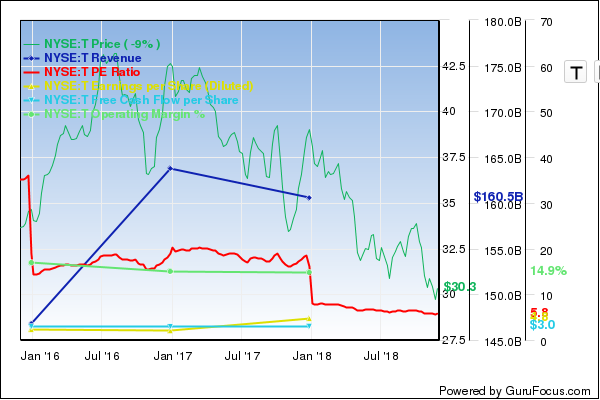AT&T's Stock and Bondholders Concerned About Debt Load
- By John Kinsellagh
After participating in the media merger frenzy earlier in the year with its purchase of Time Warner, AT&T (NYSE:T) now has the dubious distinction of being the most indebted nonfinancial company in the U.S.
As of the end of the third quarter, AT&T had $185 billion in debt, $82 billion of which was for purchasing Time Warner, so the company could compete with original content behemoth Netflix (NFLX) in the massive and lucrative digital content streaming market.
Warning! GuruFocus has detected 4 Warning Signs with T. Click here to check it out.
The intrinsic value of T
The staggering sum paid to purchase Time Warner has sparked justifiable concern among shareholders about the burden these expenses will create for the company's balance sheet. In an era of continually rising interest rates, shareholders' anxiety is only heightened.
Given the purchase price for Time Warner, the current dilemma for the company is that investors expect its entry into the streaming market fray will quickly enhance free cash flow. But building an original content business to compete against Netflix will require a substantial and continuous investment. But in order to embark upon a meaningful debt-reduction plan, the company will need to dedicate a significant sum of its cash flow to lessen its current interest costs.
The amount of AT&T's debt in and of itself is not primarily the cause for concern, but the additional expense the company will incur if it attempts to refinance its BBB-rated bonds in a changing environment of rising interest rates. With the end of quantitative easing, the spread for assuming the risk of holding lower-grade debt has been steadily increasing,
Shareholders are pressuring the company to make debt reduction a priority because the interest costs alone on AT&T's fixed-rate debt amounts to $6.3 billion annually. The annual cost for paying out the dividend is $14 billion per year. If AT&T wants to continue its current dividend, redeem 9 billion in bonds maturing next year and pay its interest costs, it will cost approximately $30 billion. Should the need arise, the company also could cut its current 50 cent dividend, even though it has raised the rate for 34 consecutive years. This undoubtedly would have an adverse effect on the price of the stock.
The company's current cash flow of $39.3 billion is more than enough to cover these costs. During its latest quarterly earnings call, AT&T announced it was reducing its massive debt load to 2.5 times earnings before interest, taxes, depreciation and amortization by the end of 2019. The company has little choice but to meet this goal as its current BBB rating would be in danger of being dropped a notch to junk bond status, impairing its ability to access the bond markets with an interest rate that is not unduly burdensome.
Many investors know that given the steep acquisition costs, there will be little room for error in the business strategies for maximizing the return on its Time Warner investment. The accelerated rate of cord cutting has only heightened their concerns.
For the moment, the interests of AT&T's stock and bondholders are in tandem. That status may change in the future, however, should the company fail to achieve a sufficient return to justify the $82 billion it paid for Time Warner.
The company believes that refinancing risks after its Time Warner acquisition will be minimal. That projection, however, is based on AT&T's ability to generate sufficient cash flow from its combined operations.
But that assumption, in turn, relies on AT&T's ability to quickly generate revenue from its new original content business. So far, the company, like other legacy media corporations, is struggling to make the transition into the direct-to-consumer streaming business.
Disclosure: I have no positions in any of the securities referenced in this article.
Read more here:
This article first appeared on GuruFocus.
Warning! GuruFocus has detected 4 Warning Signs with T. Click here to check it out.
The intrinsic value of T

